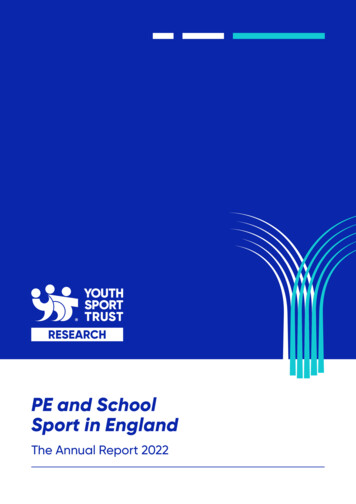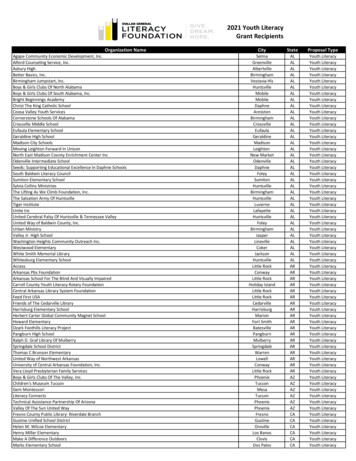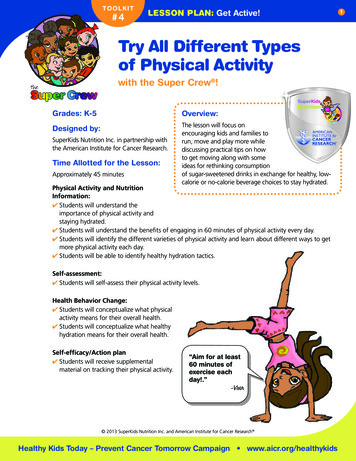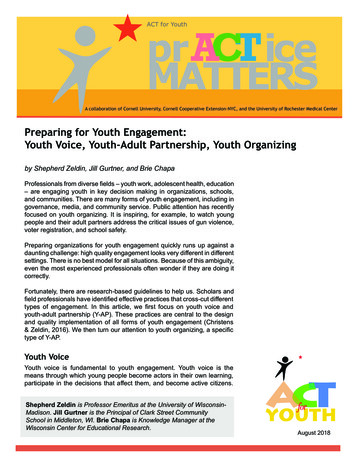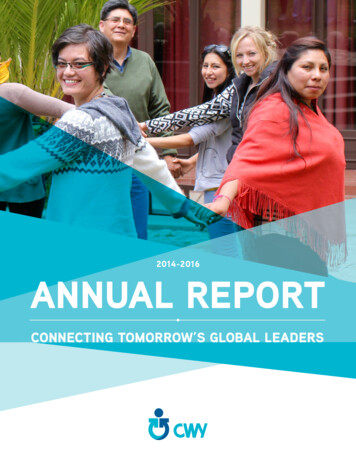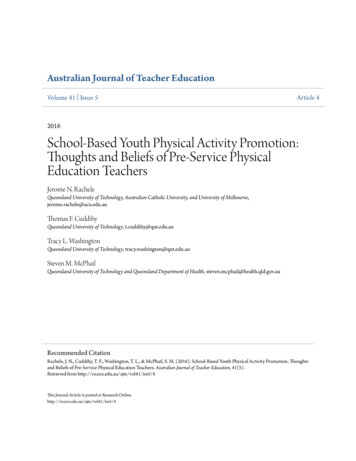
Transcription
Australian Journal of Teacher EducationVolume 41 Issue 5Article 42016School-Based Youth Physical Activity Promotion:Thoughts and Beliefs of Pre-Service PhysicalEducation TeachersJerome N. RacheleQueensland University of Technology, Australian Catholic University, and University of Melbourne,jerome.rachele@acu.edu.auThomas F. CuddihyQueensland University of Technology, t.cuddihy@qut.edu.auTracy L. WashingtonQueensland University of Technology, tracy.washington@qut.edu.auSteven M. McPhailQueensland University of Technology and Queensland Department of Health, steven.mcphail@health.qld.gov.auRecommended CitationRachele, J. N., Cuddihy, T. F., Washington, T. L., & McPhail, S. M. (2016). School-Based Youth Physical Activity Promotion: Thoughtsand Beliefs of Pre-Service Physical Education Teachers. Australian Journal of Teacher Education, 41(5).Retrieved from http://ro.ecu.edu.au/ajte/vol41/iss5/4This Journal Article is posted at Research Online.http://ro.ecu.edu.au/ajte/vol41/iss5/4
Australian Journal of Teacher EducationSchool-Based Youth Physical Activity Promotion: Thoughts and Beliefs ofPre-Service Physical Education TeachersJerome N RacheleQueensland University of Technology, Australian Catholic University; University of Melbourne,Tracy L WashingtonThomas F CuddihySteven M McPhailQueensland University of TechnologyAbstract: Physical education teachers are central to the facilitation ofschool-based physical activity promotion. However, teachers have selfreported a lack of knowledge, skills, understanding, and competence tosuccessfully implement these strategies. The aim of this investigation wasto explore the beliefs and perceptions of pre-service physical educationteachers, concerning their potential roles in future school-based programsdesigned to promote student physical activity. Fifty-seven pre-servicephysical education teachers (21 males and 36 females) had complete dataand were included in the analysis. Participants responded positively, anddid not reveal concerns about their capacity to facilitate school-basedphysical activity promotion during practicum, and prospectively aspractising teachers. This may indicate that either this particular tertiaryinstitution provides curriculum which adequately prepared participants;or participants had misconceptions about their ability and preparedness tofulfill this role. This investigation provides important empirical evidencefor preparing pre-service physical education teachers in their potentialfuture roles.BackgroundPreventative health, consisting of measures taken for disease prevention, has become thefocus of contemporary health care; identifying physical activity as key in determining anindividual’s current and future health and functioning (Australian Institute of Health andWelfare, 2010; World Health Organization, 2004). Past measures have included mass mediacampaigns aimed at adults, such as “How do you measure up?”, and “Swap it don’t stop it”(Deparment of Health, 2015). However, the focus of these health promotion measures has nowturned to youth (e.g., “Get set 4 life”). This is in light of a number of investigations which havefound adolescent physical activity to increase the likelihood of maintaining positive lifestylebehaviours throughout adulthood (Herman, Hopman, & Craig, 2010; Ross, Larson, Graham, &Neumark-Sztainer, 2014).The majority of the ill-effects of physical inactivity, such as the onset of chronic disease,may not manifest until adulthood. There are however, numerous other reasons for youth to beengaged in regular physical activity. A systematic review by Janssen and LeBlanc (2010)Vol 41, 5, May 201652
Australian Journal of Teacher Educationrevealed youth physical activity to be associated with a variety of health benefits including;improvements in adiposity, metabolic syndrome, high-density lipoproteins, triglycerides,hypertension, anxiety symptoms, depression symptoms, self-concept, academic performance,bone strength, and physical fitness; while further empirical studies have found youth physicalactivity to be associated with numerous aspects of wellness (Rachele, Cuddihy, Washington, &McPhail, 2014). Additionally, dose-response relationships from observational studies haveindicated that the greater the amount of physical activity engaged in by youth, the greater thehealth benefit. Similar relationships are found for the intensity of physical activity undertaken.While substantive health benefits can be achieved for physical activity performed at moderateintensities, even greater benefits are obtained for vigorous intensities (Janssen & LeBlanc, 2010).Despite the recognized benefits of increased physical activity engagement, large portions ofyouth still fail to meet the minimum amounts of physical activity required to obtain healthbenefits. According to the most recent report from the world’s most comprehensive crossnational study, the Health Behavior in School-aged Children (HBSC) study (Currie et al., 2012),77% of 11 year olds reported less than one hour of moderate-to-vigorous physical activity perday, along with 81% of 13 year olds, and 85% of 15 year olds. Recent Australian data from the2009-10 National Secondary Students’ Diet and Activity survey revealed that 85% of secondaryschool students from years 8-11 across 237 schools across Australia (n 12,188) reported notengaging in sufficient levels of physical activity to provide health benefits (Cancer CouncilAustralia, 2011), according to the then Department of Health and Ageing’s physical activityrecommendations for 12-18 year olds (2004).Schools have become critical settings for health promotion strategies aimed at increasingyouth physical activity due to distinct and unique methodological circumstances (Rachele,Cuddihy, Washington, & McPhail, 2013): the World Health Organization specifically identifiedschools as a target setting for the promotion of physical activity amongst youth (World HealthOrganization, 2004). Schools are an ideal setting for population-based physical activitymeasurement and interventions (Dobbins, DeCorby, Robeson, Husson, & Tirilis, 2009; Rachele,McPhail, Washington, & Cuddihy, 2012). They provide one of the few opportunities to addressthe full range of individuals in a population, and a last chance to access, at no extra cost, acaptive audience. Schools also have an inherent responsibility to promote physical activity viacurriculum (though its implementation will usually depend on the corresponding documentationor policy) (Corbin, 2002); and to develop citizens who are “physically educated” (Charles &Thomas, 2008). Furthermore, schools are the actual environment where youth live and develop,while experiences within school profoundly influence the establishment of lifestyle behaviours(Alibali & Nathan, 2010). Therefore, while youth physical activity promotion strategies at schoollevel (e.g., during lunch breaks, after-school programs, or those facilitated through curriculum)may have immediate impacts on youth, behaviours adopted during this time are likely to haveadditional lifelong effects. School-based interventions also build on social-ecological theory,which proposes multiple dimensions of influence, and hypothesize that self-regulation is difficultto establish without broader social and institutional support (Dzewaltowski, 1997).The role of physical education teachers has long been identified as key to the promotionof physical activity within schools. It has been suggested that physical education teachereducation programs in tertiary institutions, in addition to teaching physical education content andpedagogical skills, should be expanded to prepare future physical education teachers to developnatural linkages to physical activity and public health (Charles & Thomas, 2008; McKenzie &Kahan, 2004). A recent Cochrane review found that studies using physical education teachers asVol 41, 5, May 201653
Australian Journal of Teacher Educationthe providers of interventions reported a significant effect, more often than those using generalteachers to implement school-based physical activity interventions (Dobbins et al., 2009). In arecent study of 9 and 15 year-old Norwegian school children, physical activity specific teachersupport was a significant predictor of physical activity during non-curricular school time(Ommundsen, Klasson-Heggebø, & Anderssen, 2006). Physical education teachers, although notpresent in the leisure-time physical activity context, have also been shown to serve an equallyimportant role to parents in supporting adolescents’ leisure-time physical activity (McDavid,Cox, & Amorose, 2012). Importantly, studies have found that teachers generally have positiveviews towards school-based physical activity promotion (Cale, 2002). Although of concern,participants from these same studies identified a lack of knowledge and preparedness to dealwith adolescent health issues, and had limited understanding of how to approach school-basedphysical activity promotion (Cale, 2002; St Leger, 1998). In a recent case study conducted byTorill, Oddrun, and Hege (2013) of eight Norwegian schools, a self-reported lack of skills andcompetence from teachers was partially attributed to a failure to implement national physicalactivity policy. Further, in a study of physical education teachers in England, Green (2000) notedthat physical education teachers philosophical views of physical education in general weresometimes overlapping, contradictory, ill thought-through and confused.Given the potential for physical education teachers to play a role in school-based healthpromotion strategies, it is essential that pre-service teachers are provided with adequate trainingthat prepares and empowers them with the required skills to be successful lifelong healthpromoters. The purpose of this study was to explore pre-service secondary school physicaleducation teachers’ beliefs concerning the promotion of school-based physical activity amongstudent populations.MethodsThis study involved cross-sectional online questionnaire data from pre-service physicaleducation teachers. Questions were developed to address the purpose of the study.ParticipantsThis investigation included 59 (21 male and 38 female) pre-service physical educationteachers from a metropolitan university in Brisbane, Australia. Participants were enrolled ineither a single or dual bachelor of education degree, majoring in health and physical education.This course prepares students to deliver the Australian Curriculum, teaching under the NationalProfessional Standards for Teachers; and is recognized by the Australian Institute for Teachingand School Leadership and Queensland College of Teachers. Thirty-six participants wereenrolled in single degrees, while 23 were enrolled in dual degrees (education and exercisescience). Enrolled alternative teaching areas (in addition to physical education) varied with; 15 inbiology, 13 in English, 13 in mathematics, 11 in health education, three in history, two ingeography, two in business communication and technologies, and one for each of physics, legalstudies, home economics, information technology, and the studies of society and environment(with some participants teaching in more than one alternative area).Vol 41, 5, May 201654
Australian Journal of Teacher EducationInstrumentsSurvey QuestionsCurrent literature surrounding physical education teachers provided themes for whichquestions were based. These included: the roles of physical education teachers (McDavid et al.,2012), supplementary school-based programs outside of the allocated curriculum (Beets,Beighle, Erwin, & Huberty, 2009), features of effective school-based programs (Dobbins et al.,2009), and attitudes toward potential involvement in supplementary school-based programs(McDavid et al., 2012). All customized survey questions were subjected to cognitive pre-testingmethods, such as those used by Collins (2003).Three survey questions were developed to establish the perspective of participants. Thesequestions comprised: “Do you believe that student physical activity promotion is a part of yourrole as a pre-service teacher?”; “Do you believe that student physical activity promotion is apart of the role of physical education teachers?”; and, “Do you believe that student physicalactivity promotion is a part of the role of teachers who do not teach physical education?”.Participants responded categorically (i.e., yes/no/unsure).Four open-ended survey questions were developed to explore the underlying themes ofyouth physical activity promotion in secondary schools. This was the study’s main focus andwas, by definition, exploratory. The questions were: “Who do you believe is responsible for thepromotion of student physical activity?; “What do you believe would be effective to promotestudent physical activity?”; “How would you feel about being involved in a program designed topromote physical activity amongst students at your school during your practicum experience?”;and, “How would you feel about being involved in a program designed to promote physicalactivity amongst students at your school, when you are a teacher?”ProcedureData collection was undertaken over a 4 week period of the teaching semester.Participants received an email from the chief investigator via the Queensland University ofTechnology’s Blackboard service. The email invited the recipient to participate in the study, andcontained a link to an online survey hosted by Queensland University of Technology’s KeySurvey. After consultation with the unit course coordinator, an online survey was deemed themost suitable and efficient method of collecting data. As all students had university access to theonline survey, it was not anticipated that any bias would emerge as a result of using this method.This study was approved by the Human Research Ethics Committee of the QueenslandUniversity of Technology, with appropriate permissions obtained from the head of departmentand course coordinator prior to undertaking data collection.Data AnalysisOverall, a total of 57 (97%) participants (21 males and 36 females) had complete data andwere included in the analysis. Participant demographics can be found in Table 1. Descriptivestatistics were analyzed in IBM Statistical Package for the Social Sciences (SPSS) version 21.Open-ended survey questions were analyzed via thematic analysis. Briefly, thematic analysis is amethod for identifying, analyzing and reporting patterns (themes) within data (Virginia &Victoria, 2006). Although thematic analysis is typically used for self-report interview data, it canVol 41, 5, May 201655
Australian Journal of Teacher Educationalso be used to analyze text as long as the questions asked are open-ended (Hayes, 2000).Following previously used methods (Warner & Griffiths, 2006) the researchers read thecomments twice to become familiar with the data, then searched for the main themes to emergefrom each of the questions. Each of the questions were analyzed separately, with responsescollated under emerging theme headings. Provisional headings and definitions were thenprovided under each emerging theme. The responses were then re-read to see if they containedany further relevant information to the provisional themes. Themes were then given their finalanalytical form and definition. Comments from participants have been selected to represent thebreadth and depth of themes and are reported verbatim.n 57 participantsn (%)GenderMaleFemale21 (36.8)36 (63.2)Undergraduate training (years)1234516 (28.1)20 (35.1)13 (22.8)6 (10.5)2 (3.5)Qualification enrolledSingle degree34 (59.7)Dual degree23 (40.4)Table 1. Participant demographics in the analytic sampleResultsThe mean age (standard deviation) of participants was 21.94 (4.53) years, with a range of17.48 – 35.31 years. The median (inter-quartile range (IQR)) number of practicum experiencedays was 20 (0-20), with a range of 0 – 60 days.Beliefs about the Roles of TeachersFifty-one (90%) participants believed it part of their role as a pre-service teacher topromote student physical activity, with 9 (10%) opposed. Fifty-five (97%) participants believedstudent physical activity promotion to be a part of the role of physical education teachers, withone (2%) opposed, and one (2%) unsure. Forty-seven (83%) participants believed studentphysical activity promotion to be a part of the role of teachers who do not teach physicaleducation, with eight (14%) opposed, and two (4%) unsure.Vol 41, 5, May 201656
Australian Journal of Teacher EducationThematic AnalysisThe following section describes the key themes produced. Each theme produced anumber of categories, which are presented below with reference to participant examples. Thethemes, identified from open-ended research questions of the beliefs of pre-service physicaleducation teachers, the categories within each theme, and participant comments are presented inTable 2.In response to the first question, participants believed that parents, teachers, and‘everyone’ were responsible for the promotion of students’ physical activity. For the secondquestion, participants believed that demonstrating the rewards or benefits of involvement, theneed for programs to be fun, the inclusion of role models, and the provision of additionalopportunities to be active including sports and school-based competitions would be effective topromote student physical activity. Due to the homogeneity in participant responses, the responsesto the third and fourth questions were merged to create one topic being “attitude towardsinvolvement in supplementary school-based programs to promote student physical activity”.Participants responded both positively and enthusiastically, had intentions or expectations to beinvolved in student physical activity promotion, and had concerns about the amount of time thatinvolvement would encompass.Vol 41, 5, May 201657
Australian Journal of Teacher EducationResponsible for promoting youth health behaviorsEffective school-based programsParents “Parents, teachers, governments” “Parents, Teachers, the School and the Studentsthemselves” “Parents firstly are obligated, teachers have noobligation but they should show an interest in it.”Teachers “Teachers, parents, friends and peers” “Teachers, parents, role models and professionalathletes” “Every teacher” “All teachers, parents and senior staff members” “All teachers should participate in promotingexercise.” “All teaching staff at the school.”Everyone who is a member of the communityShow the rewards / benefits of involvement “Educating students on the long term benefits ofactivity” “Educating students on the long term effects of notparticipating in activity” “Showing the rewards of being physically fit”.Programs need to be fun “everyone”“Everyone in society! Parents, leaders, peers,teachers.”“Everybody from, teachers, to health graduates toparents” Involvement in supplementary school-basedprogramsPositive and enthusiastic towards involvement “I would participate if I could”. “I would feel privileged!”; “I would love to be involved”; “Awesome!” “It is something I would get behind 100%”Intent or expectation to be involved“Make it fun”“FUN AND ENJOYMENT!!!!!!”“Make it fun, interactive (obviously), and rewarding”“Emphasizing games and fun.”“focus more on the topics of how it can be fun”“Make it more fun and engaging :)”Role models “.Elite athletes visiting schools and doingdemonstrations.”“I believe TV role models would effectively promotephysical activities within student lives”“enthusiastic role models” “As a Health and Physical Education teacher Iwould expect to be involved in a program topromote physical activity.”“If someone doesn't come up with an officialprogram I would try to do it myself.”“I would expect to be if teaching as a PE teacher”Concerns about time “I would be happy to do so provided time permits” “.field experience is extremely time consumingwith planning, extracurricular actives etc. It maybe difficult to fit in.” “It is difficult to build a rapport with studentswhile on prac due to the time restrictions”Provide additional opportunities, sports, and competitions “More organized opportunities for students to not onlyparticipate in physical activity in school but also theopportunity to continue that outside of school.” “Have certain competitions which allow all students toplay” “More physical activity event days or competitions”Table 2. Themes identified from open-ended research questions of beliefs of pre-service physical education teachers, including categories within each theme.Vol 41, 5, May 201658
Australian Journal of Teacher EducationDiscussionOverall, 90% (n 51) of participants believed it a part of their role as a pre-serviceteacher to promote student physical activity, with 97% (n 55) also believing the same forpracticing physical education teachers. Participants provided three categories for whom theybelieve is responsible for student physical activity promotion. The diversity of partiesidentified by participants may have key implications regarding their support for futureschool-based interventions. Social-ecological models propose multiple dimensions ofinfluence and hypothesize that self-regulation is difficult to establish without broader socialand institutional support (Dzewaltowski, 1997). Participants in this study would thereforelikely support interventions which involve influences from multiple parties. Second, parentsand teachers (as identified by participants) have been common providers of past school-basedphysical activity promotion interventions (Dobbins et al., 2009). These findings also tap intoa broader issue around the strategies for youth physical activity promotion, and the bodiesthat should be charged with facilitating such programs. National physical activity guidelinesstate that adolescents should engage in at least 60 minutes of moderate to vigorous physicalactivity per day, on most days per week (Australian Government Department of Health,2014). Sufficient engagement in physical activity among youth yields numerous benefits(Blair & Morris, 2009; Faulkner, Buliung, Flora, & Fusco, 2009; Hamer, Stamatakis, &Steptoe, 2009; Haskell, Blair, & Hill, 2009; Kim & Lee, 2009; Sattelmair et al., 2011;Scarmeas et al., 2009; Wen et al., 2011; Woodcock, Franco, Orsini, & Roberts, 2011), bothnow and in the long-term. Much conjecture lies around what role schools, and by extensionteachers, should play in physical activity promotion: particularly around whether schoolshave a responsibility only to deliver a set curriculum, or play an active role in the broaderphysical and mental development of youth. Given the available evidence of the success ofschool-based interventions, surely not engaging youth in schools about the benefits ofphysical activity (and the risks of inactivity) (Australian Government Department of Health,2014) would be a missed opportunity.In this study, four themes emerged from what participants believed would be effectivefor promoting student physical activity. It is significant that participant responses, namely‘showing the rewards / benefits of physical activity’, ‘making it fun’ and ‘providingadditional opportunities’, are also among the most commonly used strategies to promoteschool-based physical activity among youth (Dobbins et al., 2009). Of particular note is thatphysical education teachers would likely be the facilitators of each of the strategies identifiedby participants. It is therefore important that participants in this study believed studentphysical activity promotion to be a role of both pre-service (90%), and practicing (97%)physical education teachers, while they also responded positively and enthusiastically withrespect to their willingness to be involved in such programs. Applying strategies that areidentified by program facilitators (e.g. showing the rewards / benefits, making it fun, rolemodels, providing additional opportunities, more sports, and competitions) may haveimplications for program success. Evidence shows that including program facilitators in theirdesign (allowing facilitators to adapt programs to the ecological niche in which they areworking) increases the quality of program delivery, and measureable health outcomes(Berkel, Mauricio, Schoenfelder, & Sandler, 2011).In relation to teacher willingness to be involved in student physical activity promotioninterventions, the findings from this study are consistent with previous literature. Participantsin this study gave positive and enthusiastic responses when asked how they would feel aboutbeing involved in a program designed to promote physical activity among students at theirschool, both during their practicum experience and when they are practicing teachers. Theseresults are congruent with existing Australian (St Leger, 1998) and international (Cale, 2002)Vol 41, 5, May 201659
Australian Journal of Teacher Educationliterature on practicing teachers’ understandings of health promotion in schools, who werefound to be very supportive of the concept. Concerning their future as practicing teachers,participants indicated that they either intended, or expected to be involved in such programs.This suggests that participants were aware of their likely involvement as facilitators in futureprograms. Finally, participants were also concerned about the time that involvement inschool-based physical activity promotion programs would occupy. This is understandable aspre-service teachers often have additional issues which may take precedence over theprolonged ill-effects of youth physical inactivity. These include issues where pre-serviceteachers may lack experience, such as lesson delivery. This is in addition to managing thenumerous demands placed on pre-service teachers, such as managing relationships with theirteaching mentors and university supervisors (Ballinger & Bishop, 2011), and being evaluated(and self-evaluated) on teaching performance (Tinning, Macdonald, Wright, & Hickey,2012). It should be noted however, that these responses were preceded by questions askingabout participants’ beliefs about school-based physical activity promotion. It is possible thatthe presence of these questions may have influenced responses to the following open-endedquestions. To this end, the results also highlight the limitations of undertaking qualitativeresearch via online questionnaires.Several studies have found that teachers have a self-reported a lack of knowledge andpreparedness to deal with adolescent health issues, limited understanding of how to approachschool-based physical activity promotion (Cale, 2002; St Leger, 1998), and in some cases, alack of skills and competence to successfully implement physical activity policy (Torill et al.,2013). Critically in this study, participants did not identify any limitations which may impactupon their ability to successfully promote youth physical activity in school settings. Thisfinding may mean one of two possibilities. First, it is possible that this deficiency (lack ofknowledge and preparedness to deal with adolescent health issues) has been recognized bythe tertiary institution which participants are attending, and the need has been met toadequately prepare its students for this potential role. Second, pre-service teachers may havemisconceptions about their ability and preparedness to fulfill the role of school-basedphysical activity promotion program facilitator.While this investigation provides valuable empirical evidence to assist with preparingpre-service physical education teachers with their potential future roles, there are severalrelated research priorities. First, the participants from this investigation were from a singleinstitution, and all completed practicum experience in schools which must abide the rules ofthe same educational organization (Education Queensland). Comparing between institutionsand education systems, either across various regions within the same country, or betweencountries may be a priority for future research. Second, this investigation did not record theparticipants’ previous practicum experience schools, and the physical activity policies,campaigns, and initiatives that existed within those schools. Investigating pre-serviceteachers’ experiences, concurrent with evaluations of physical activity promotion programsmay also be a priority for future research. Lastly, this investigation assessed pre-serviceteachers at one time-point within their undergraduate tertiary degrees. Longitudinal cohortstudies which assess participant beliefs from the beginning of undergraduate involvement,through to the early stages of their teaching careers is likely to improve our understanding ofthe beliefs of physical education teachers toward youth physical activity promotion in schoolsettings.School-based physical activity promotion is an important element of pre-servicephysical education teacher education, and the ongoing professional development of practicingphysical education teachers. The role of physical education teachers in school-based physicalactivity promotion is likely to continue into the future; given the rates of physical inactivity inthe Australian population (Australia Bureau of Statistics, 2013), and the previous success ofVol 41, 5, May 201660
Australian Journal of Teacher Educationschool-based programs (Dobbins et al., 2009). This study found participants respondedpositively to their potential roles as the facilitators of future school-based physical activityprograms. Participants in this study also did not reveal any concerns about their capacity tofacilitate school-based physical activity promotion programs during practicum, andprospectively as practising teachers; as opposed to previous studies in this field. This mayindicate that either this particular tertiary institution has provided curriculum whichadequately prepared participants; or participants had misconcepti
jerome.rachele@acu.edu.au Thomas F. Cuddihy Queensland University of Technology, t.cuddihy@qut.edu.au Tracy L. Washington . enrolled in single degrees, while 23 were enrolled in dual degrees (education and exercise science). Enrolled alternative teaching areas (in addition to physical education) varied with; 15 in .
